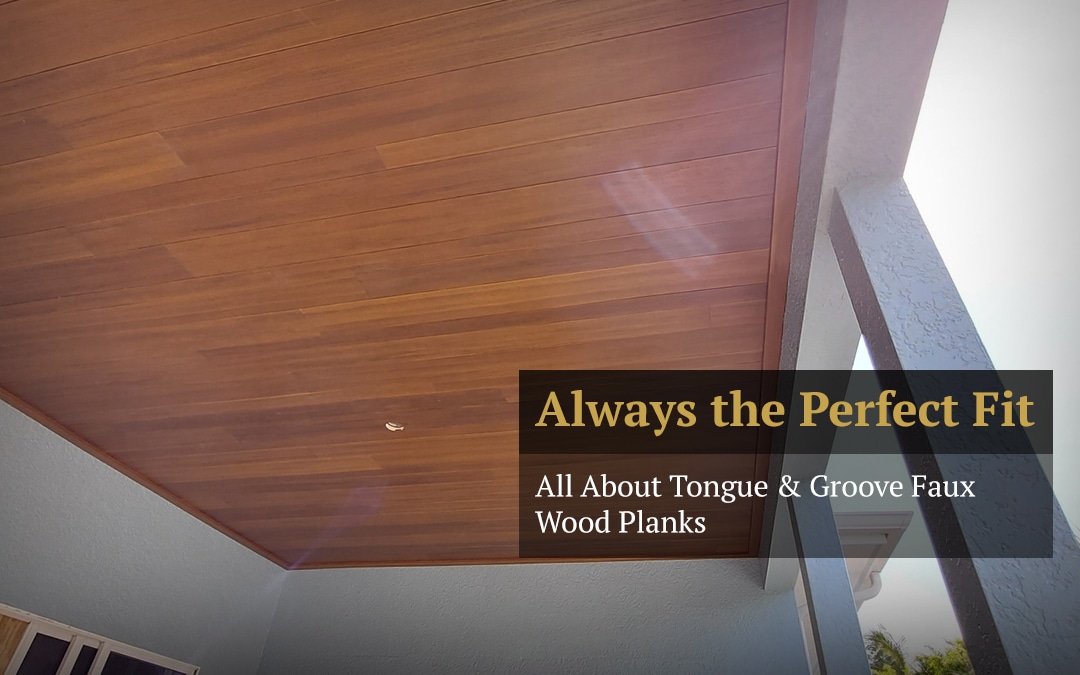Tags: Faux Tongue & Groove Ceiling Planks, Faux Tongue & Groove styles, Faux Wood Beams, Faux Wood Ceiling Beams, Tongue & Groove Faux Wood Planks
Do you ever wish you could get the luxury of hardwood in your home, but don’t want to pay the price tag? Does the maintenance requirement scare you away from having real wood floors? Do you want to avoid the hassle and expense of having workers in your house for days installing a wood ceiling or feature wall?
Tongue and groove faux wood planks can be the solution to all these problems and more. Read on to learn about how these planks can get you the wood look you love, hassle-free.
What Is Faux Wood?
So what is faux wood anyway, and is it really as good as the real article? Faux wood planks are visually identical to real wood and are much easier to install and maintain. They are made of polyurethane and, as we’ll discuss later, are carefully manufactured to imitate real wood as closely as possible.
Today’s faux wood is nothing like the peel and stick vinyl we all grew up hating. These boards are beautiful and make for a great accent anywhere in your home. They are also more affordable and sustainable than real wood and don’t require nearly the maintenance hassle.
How Is It Made?
Each faux wood plank begins with manufacturers taking a mold of a real wood board. This ensures that you get the knots, whorls, and unique grain patterns that characterize genuine wood. These molds are then used to produce polyurethane replicas or the original boards themselves.
Once the polyurethane boards have set, manufacturers hand paint each board to mimic real wood. They include small variations in grain color and texture to give them a genuine look. When the boards are finished, the only way you could tell that they are fake is by picking one up.
Benefits of Using Faux Wood
There are a number of great benefits to using faux wood in your home. For one thing, although each board has the small variations in color and texture that characterize real wood, they all stick to the same basic color. You don’t have to worry about pulling a board out of the box that’s a completely different color than everything you’ve already installed.
Real wood requires polishing and refinishing every few years – a huge task that can cause a lot of hassle and expense. But polyurethane doesn’t need any maintenance – you can simply install it and enjoy your new faux wood planks. Faux wood is also much lighter than genuine wood, making it ideal for ceiling installations.
What Is Tongue and Groove?
Tongue and groove boards make installing your own faux wood planks a simple project. Each board has a thin protruding “tongue” cutout on one of the long edges, usually with a slight lip cut into the underside of it. The opposite long edge has a groove cut into it which matches the tongue on the other side of the board.
These tongues and grooves snap together to form one cohesive piece of material. Often, these boards will have smaller tongues and grooves on the short ends to keep them joined endwise, too.
Benefits of Tongue and Groove
One of the biggest advantages of using tongue and groove planks is how easy they are to install. Traditional boards require clamping, gluing, and a good deal of nailing through the face of the boards to keep them in place. And then traditional flooring is locked in place, with no room to expand and contract with normal changes in temperature and humidity.
Tongue and groove flooring snaps together and instantly forms a cohesive unit with little to no face nailing required. You can install a floating floor that has plenty of room to move as the weather changes without buckling or leaving gaps. And thanks to the installation method for tongue and groove planks, you can avoid driving nails through the faces of all your beautiful boards.
How to Install It
Installing tongue and groove planks is a simple process. You’ll start in one corner of your floor, ceiling, or wall with a board that has its groove edge sawn off. Place the flat edge of the board in the corner and drive a few nails through the face of it (this is almost the only time you’ll have to do this, we promise).
Line up another trimmed board on the end of your first board, tap it gently to lock the tongue and groove in place, and nail it down. Once you have your first row in place, lay the first board of your second row, tapping it to lock the longue and groove and then driving a nail through the corner of the tongue into your wall, floor, or ceiling. Continue this way across your whole space, nailing your final board through the face.
Where to Use Tongue and Groove Faux Wood Planks
There are a number of wonderful spots in your home where you can use faux wood tongue and groove boards. For one thing, they can make gorgeous flooring that gives you the look of hardwood without the cost. These floors are also much more durable, meaning you won’t have to worry about the finish wearing off in high-traffic areas.
You can also use faux wood planks to create an accent wall in your home. You can even hang them on your ceiling, thanks to their stunning appearance and lightweight. Either of these options will give your home a beautiful, elevated air.
Find the Best Faux Wood for Your Home
Tongue and groove faux wood planks can be one of the best materials to upgrade your home with. The faux wood planks can give you that gorgeous hardwood look without the attached hassle. And tongue and groove planks are so simple to install, you can upgrade your home in a weekend.
If you’d like to find the best faux wood tongue and groove planks on the market, check out the rest of our site at Diamond Resin Products. We provide premium American-made beams that give you the best design, quality, and value. Shop our tongue and groove planks today and start upgrading your home the easy way.

